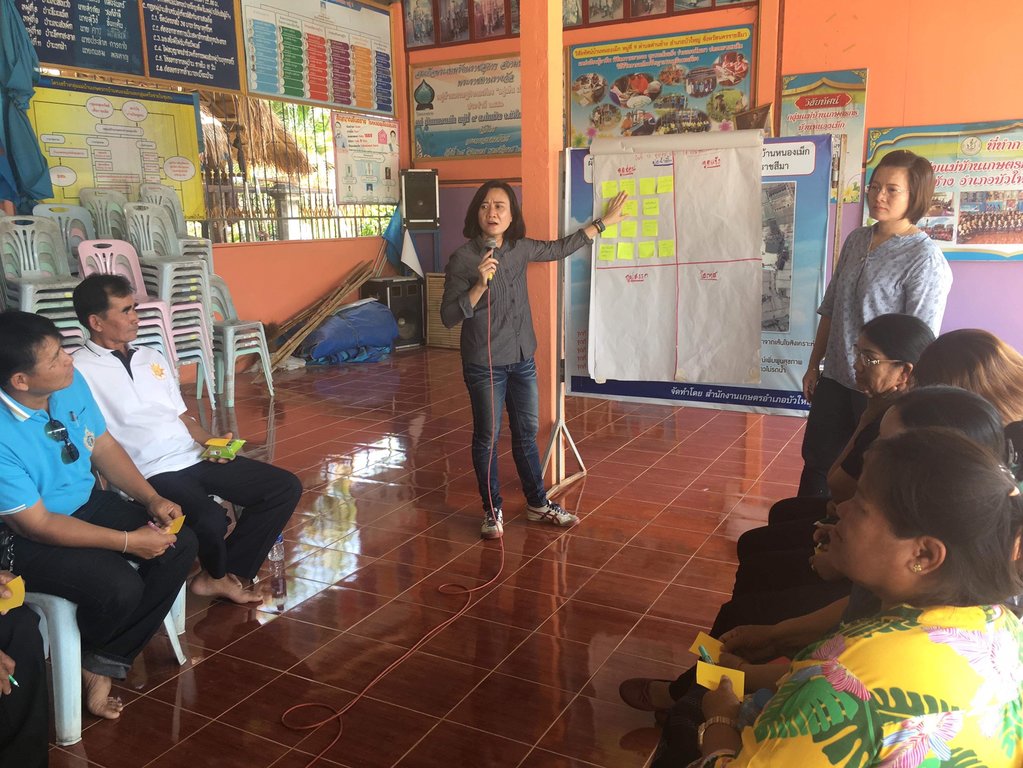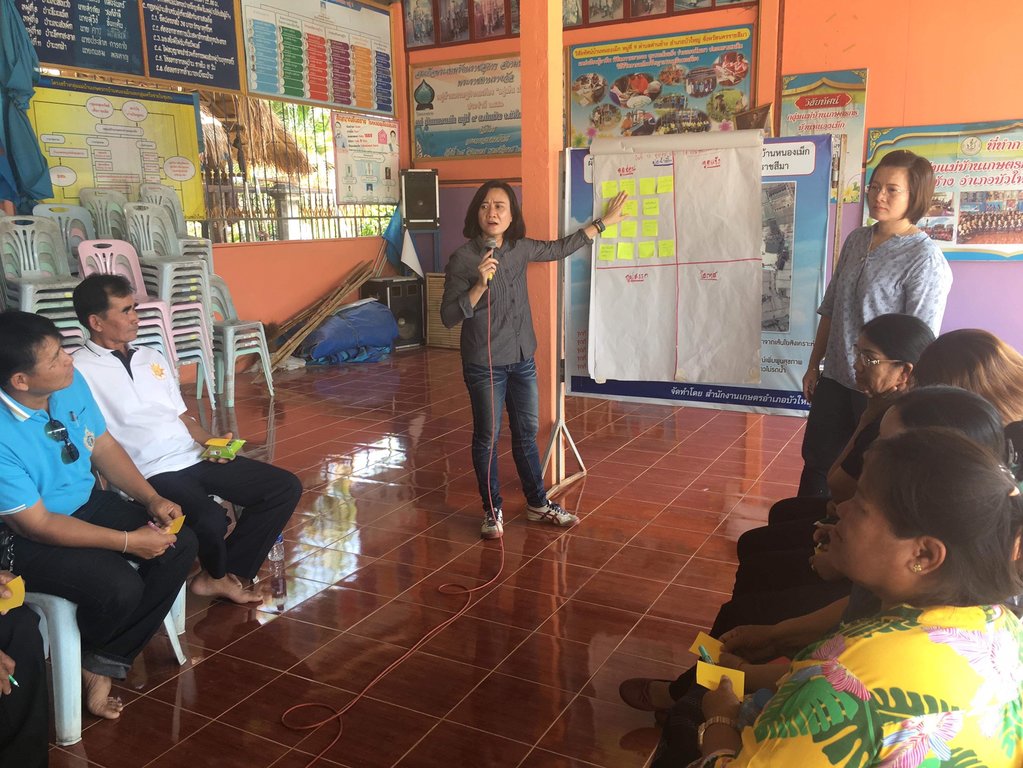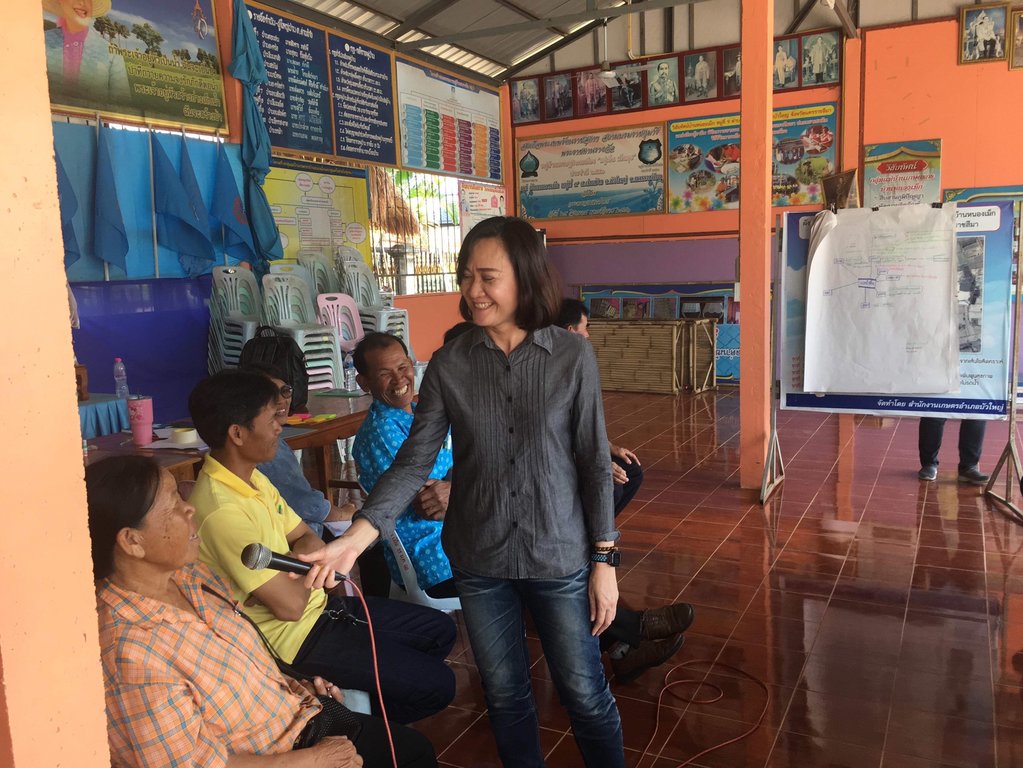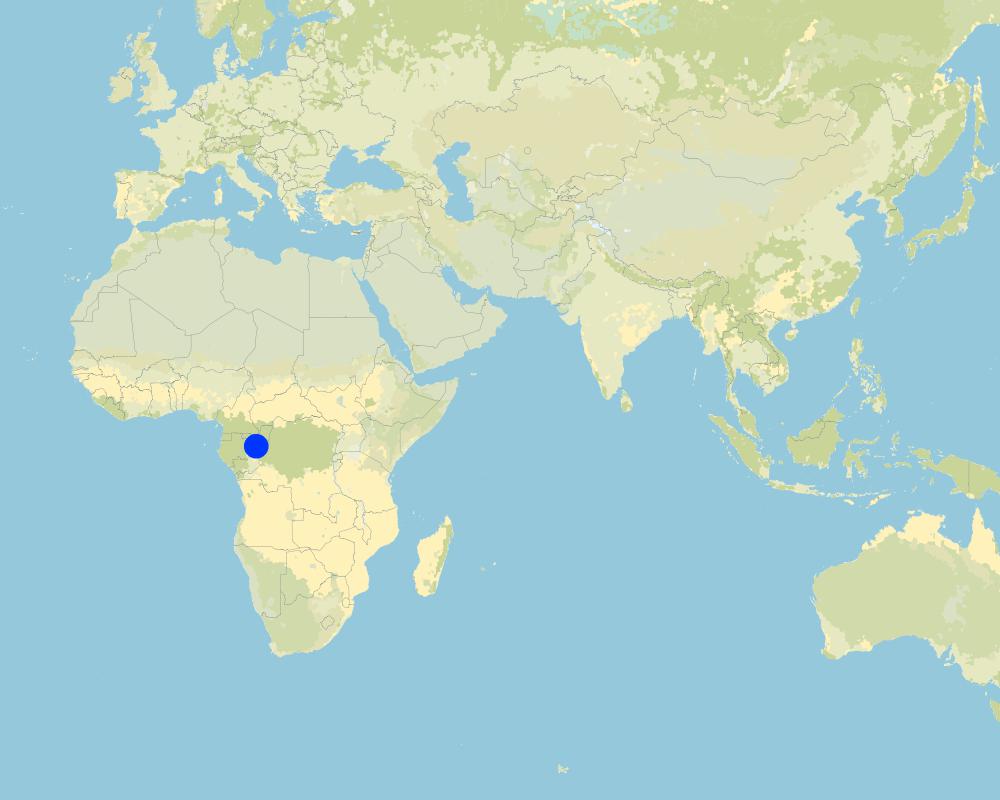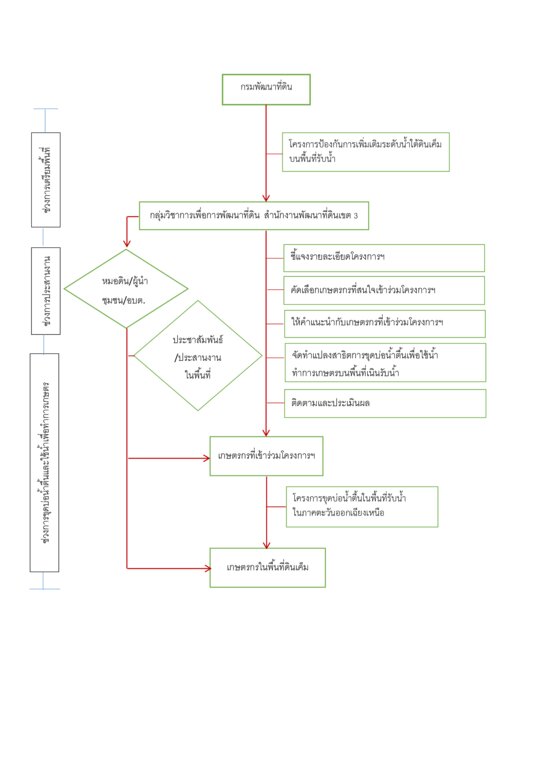Project for preventing soil salinity lowering the groundwater tables [Thailand]
- Creation:
- Update:
- Compiler: Saowanee Prachansri
- Editor: –
- Reviewers: Samran Sombatpanit, Rima Mekdaschi Studer, Pitayakon Limtong, William Critchley
Shallow well Project
approaches_4445 - Thailand
View sections
Expand all Collapse all1. General information
1.2 Contact details of resource persons and institutions involved in the assessment and documentation of the Approach
SLM specialist:
SLM specialist:
SLM specialist:
SLM specialist:
Phiprakon Apisit
044-371397
Technical for Land Development Group , Land Development Regional Office 3 , Land Development Department.
64 Moo, 7, T. Joho, A. Muang, Nakhon Ratchasima 30310
Thailand
SLM specialist:
Prawanna Prasit
044-371397
Technical for Land Development Group , Land Development Regional Office 3 ,Land Development Department.
64 Moo, 7, T. Joho, A. Muang, Nakhon Ratchasima 30310
Thailand
SLM specialist:
National consultant:
land user:
Thathaisong Noorean
062-1521591
-
25 M. 10, T.Danchange,BuaYai, Nakhon Ratchasima
Thailand
land user:
Panikom Chartee
085-4395414
-
136/1 M. 2 T.Danchange,BuaYai, Nakhon Ratchasima
Thailand
land user:
Salanok Mongkoen
098-1181365
-
184 Moo 2 T.Danchang, A.Buayai,Nakhon-Ratchasima
Thailand
Subdistrict Administration Organization Officer:
TubseKaew Palinee
087-8706265
275 M. 9 T. Danchange, A. BuaYai, Nakhon Ratchasima 30120
Thailand
Name of project which facilitated the documentation/ evaluation of the Approach (if relevant)
Book project: where the land is greener - Case Studies and Analysis of Soil and Water Conservation Initiatives Worldwide (where the land is greener)Name of project which facilitated the documentation/ evaluation of the Approach (if relevant)
Book project: where people and their land are safer - A Compendium of Good Practices in Disaster Risk Reduction (DRR) (where people and their land are safer)Name of project which facilitated the documentation/ evaluation of the Approach (if relevant)
Best Practices for Land Degradation Control in Dryland Areas of China (Best Practices China)Name of the institution(s) which facilitated the documentation/ evaluation of the Approach (if relevant)
Land Development Department LDD (Land Development Department LDD) - Thailand1.3 Conditions regarding the use of data documented through WOCAT
When were the data compiled (in the field)?
09/10/2018
The compiler and key resource person(s) accept the conditions regarding the use of data documented through WOCAT:
Yes
2. Description of the SLM Approach
2.1 Short description of the Approach
The Land Development Department has promoted lowering of saline groundwater table in recharge areas since 2014. The approach used is through: (1) Public relations and information spreading; (2) Planning demonstration sites; (3) Selection of farmers interested in participating in the project; (4) Providing knowledge and advice to those farmers participating in the project; (5) The preparation of demonstration plots, with shallow wells, in farmers' land.
2.2 Detailed description of the Approach
Detailed description of the Approach:
Lowering shallow saline groundwater is one method of preventing the spread of salt in soils. This has been promoted under the Land Development Department (LDD) at Bua Yai district Nakhon Ratchasima province since 2014. The LDD has been drilling shallow wells to: (1) provide water for farming, (2) reduce the amount of saline groundwater, and (3) to create a positive economic impact.
The approach used is through: (1) Public relations and information spreading using soil doctors, volunteers, community leaders, and sub-district administrative organizations who clarify project details to community leaders, sub-district administrative organizations and farmers; (2) Planning demonstration sites; (3) Selection of farmers interested in participating in the project. These farmers must have agricultural land in the recharge area and within the project focus of the LDD; (4) Providing knowledge and advice to those farmers participating in the project; (5) The preparation of the demonstration plot, with a shallow well, in the farmer's land.
The demonstration plot implemented in the recharge area under Mr. Boonchu Supho is planted with rice, sugar cane and various kinds of vegetables throughout the year, for greater productivity. Importantly, even in droughts it is still possible to pump enough groundwater for the crops. Rice yield have increased up to 5-10%, surface salt patches have decreased significantly, and the surrounding environment has more vegetation and living things. The farmers outside the area and surrounding areas have come to learn in the demonstration plot and want to engage in the project. The area covered by demonstration plots has risen to about 1,000 rai (160 hectares).
2.3 Photos of the Approach
General remarks regarding photos:
All approach processes are discussed at the meeting of the project to preventing soil salinity and to lower the saline groundwater table in recharge area
2.4 Videos of the Approach
Comments, short description:
Conversation and Lesson learned
Date:
09/10/2018
Location:
T.Danchange, A. Buayai , Nakhon Ratchasima 30120
Name of videographer:
Jilayus Sommutram
2.5 Country/ region/ locations where the Approach has been applied
Country:
Thailand
Region/ State/ Province:
Nakhon Ratchasima
Further specification of location:
T.Danchange, A. Buayai
Comments:
102.386370, 15.657060
Map
×2.6 Dates of initiation and termination of the Approach
Indicate year of initiation:
2014
If precise year is not known, indicate approximate date when the Approach was initiated:
less than 10 years ago (recently)
Year of termination (if Approach is no longer applied):
2019
Comments:
This approach has been used from 2014 until now
2.7 Type of Approach
- recent local initiative/ innovative
2.8 Main aims/ objectives of the Approach
Academic Group for Land Development, Land Development Office District 3, has cooperation from soil volunteer doctor, community leaders and the district administration organization to help publicize and coordinate with farmers in the area. Thus farmers have enough water for agriculture. The result of groundwater pumping on the recharge area can reduce the amount of salty groundwater that will flow into the bottom water area. The result of this approach is reduced soil salinity. Therefore, the project to prevent the increase of groundwater levels on the recharge area. Therefore appropriate to be used in the recharge area to reduce the spread of saline soil effectively. In addition, farmers in the area need to join a large number of shallow pond excavation projects of the Department of Land Development, resulting in faster expansion
2.9 Conditions enabling or hindering implementation of the Technology/ Technologies applied under the Approach
social/ cultural/ religious norms and values
- enabling
Land use users respect the community leaders and accept the work of the Land Development Department and the Soil Volunteer Doctor, resulting in mutual learning in the same community and nearby communities
availability/ access to financial resources and services
- enabling
Housing Fund
institutional setting
- enabling
Is a government project with local authorities, subdistrict administrative organizations helping to publicize
collaboration/ coordination of actors
- enabling
Soil doctors’ volunteers and community leaders help promote and coordinate the area
policies
- enabling
The government has the policy to solve saline soil problems in the area
knowledge about SLM, access to technical support
- enabling
There is a Land Development Department staff providing knowledge in the area and farmers learn from land users
markets (to purchase inputs, sell products) and prices
- enabling
There are farmers in the village and merchants to buy by the users of the land to produce vegetables according to the needs of the local market
3. Participation and roles of stakeholders involved
3.1 Stakeholders involved in the Approach and their roles
- local land users/ local communities
Farmers in the area are both
men and women, with an
the average age of 50 years or
more
Be a technology leader and use
technology to suit the area
- SLM specialists/ agricultural advisers
The staff of the Land
Development Department
have an average age of 38
years and over
Be a knowledge provider and use technology advice
- local government
Agricultural officers from
the Tambon Administrative
Organization
Promoting jobs in the area
If several stakeholders were involved, indicate lead agency:
Public relations work in the area has staff of the district agricultural office to join the activity
3.2 Involvement of local land users/ local communities in the different phases of the Approach
| Involvement of local land users/ local communities | Specify who was involved and describe activities | |
|---|---|---|
| initiation/ motivation | self-mobilization | Developing technology by yourself |
| planning | self-mobilization | There is a plan to conduct agricultural activities in the area on their own |
| implementation | self-mobilization | Land users operate by themselves |
| monitoring/ evaluation | self-mobilization | There are soil doctors volunteers, community leaders, land users, and staff together to monitor and evaluate in the area |
3.3 Flow chart (if available)
Description:
Process for driving the guidelines to encourage technology to be implemented in Nakhon Ratchasima province
Author:
Mrs. Phatranit Chuaysanoi
3.4 Decision-making on the selection of SLM Technology/ Technologies
Specify who decided on the selection of the Technology/ Technologies to be implemented:
- mainly SLM specialists, following consultation with land users
Explain:
Farmers in Bua Yai district, Nakhon Ratchasima province has begun to dig its shallow wells since 1997 and farmers have learned in the community causing a lot of water demand for agriculture. In addition, the Land Development Department has come to prepare a demonstration plot for drilling shallow wells to use water for agriculture on the area in the area of land users, ready to advise in 2014
Specify on what basis decisions were made:
- personal experience and opinions (undocumented)
4. Technical support, capacity building, and knowledge management
4.1 Capacity building/ training
Was training provided to land users/ other stakeholders?
Yes
Specify who was trained:
- land users
Form of training:
- demonstration areas
Subjects covered:
Utilization of shallow wells suitable for agriculture, rice and vegetable cultivation
Comments:
Clarification of understanding with farmers interested in joining the shallow wells excavation project in the demonstration area is necessary because besides the farmers will receive knowledge and also see how to manage soil, plants, and water in the plot can be implemented or adjusted to suit their own area.
4.2 Advisory service
Do land users have access to an advisory service?
Yes
Describe/ comments:
1. The staff of the Land Development Department perform tasks and follow up work in the area, ready to give advice to land users, 2. Soil Volunteer Doctor, community leaders, as public relations assistants and coordinators in the area.
4.3 Institution strengthening (organizational development)
Have institutions been established or strengthened through the Approach?
- yes, moderately
Describe institution, roles and responsibilities, members, etc.
Demonstration plot of the shallow well is a learning center where is the farmers, student, and people outside can share their knowledge with each other. Moreover, there could be a center of coordination among the Land Development Department officer, land users and farmers, soil doctors volunteers and community leaders.
Specify type of support:
- capacity building/ training
Give further details:
Demonstration plot of the shallow well is a field trip center in communities where students and farmers outside the area that are interested in learning
4.4 Monitoring and evaluation
Is monitoring and evaluation part of the Approach?
Yes
Comments:
Department of Land Development officers monitor and survey the shallow well utilization agricultural uses of land users during September
If yes, is this documentation intended to be used for monitoring and evaluation?
Yes
Comments:
There are many points in this document that should be track and evaluate then, fix it or adjust it
4.5 Research
Was research part of the Approach?
Yes
Give further details and indicate who did the research:
Saline Soil Research Group of Land Development Department, evaluate the project of shallow well implementation for preventing soil salinity and spread of saline soil as farmers participating in Bua Yai District, Nakhon Ratchasima Province. Furthermore, there should be a study on the change of groundwater level to rice production in the area of integrated saline soil development project, Bua Yai District, Nakhon Ratchasima Province.
5. Financing and external material support
5.1 Annual budget for the SLM component of the Approach
If precise annual budget is not known, indicate range:
- 100,000-1,000,000
Comments (e.g. main sources of funding/ major donors):
The Land Development Department supports the excavation of shallow wells with water pumps with 5.5 hp gasoline.
5.2 Financial/ material support provided to land users
Did land users receive financial/ material support for implementing the Technology/ Technologies?
Yes
If yes, specify type(s) of support, conditions, and provider(s):
Shallow wells, equipment and installation fees
5.3 Subsidies for specific inputs (including labour)
- labour
| To which extent | Specify subsidies |
|---|---|
| fully financed | Land users operate by themselves. |
- equipment
| Specify which inputs were subsidised | To which extent | Specify subsidies |
|---|---|---|
| machinery | The Department of Land Development supports the excavation of shallow wells. | |
| tools | Land Development Department supports water pumps | |
- agricultural
| Specify which inputs were subsidised | To which extent | Specify subsidies |
|---|---|---|
| seeds | fully financed | Land users operate by themselves |
| fertilizers | fully financed | Land users operate by themselves |
- other
| Other (specify) | To which extent | Specify subsidies |
|---|---|---|
| Residence and farm pond | fully financed | Land users operate by themselves |
If labour by land users was a substantial input, was it:
- voluntary
Comments:
The land user is self-operated
5.4 Credit
Was credit provided under the Approach for SLM activities?
No
5.5 Other incentives or instruments
Were other incentives or instruments used to promote implementation of SLM Technologies?
No
6. Impact analysis and concluding statements
6.1 Impacts of the Approach
Did the Approach empower local land users, improve stakeholder participation?
- No
- Yes, little
- Yes, moderately
- Yes, greatly
Create food security, reduce expenses and increase income for households of land users
Did the Approach enable evidence-based decision-making?
- No
- Yes, little
- Yes, moderately
- Yes, greatly
Is a learning resource for other farmers to use as information to decide to accept technology.
Did the Approach help land users to implement and maintain SLM Technologies?
- No
- Yes, little
- Yes, moderately
- Yes, greatly
land user, maintain technology because they help reduce household expenses and increase household income
Did the Approach mobilize/ improve access to financial resources for SLM implementation?
- No
- Yes, little
- Yes, moderately
- Yes, greatly
The land user is used as an asset for a loan
Did the Approach improve knowledge and capacities of land users to implement SLM?
- No
- Yes, little
- Yes, moderately
- Yes, greatly
Land users have adapted and modified the SLM format to suit themselves
Landowners have increased rice production due to reduced soil salinity, resulting in increased income and increased farmers' production of rice because the salinity of the soil is also reduced
6.2 Main motivation of land users to implement SLM
- increased production
Has increased rice and sugarcane production and can grow vegetables throughout the year
- increased profit(ability), improved cost-benefit-ratio
The cost of growing rice and sugar cane is increased by pumping water from shallow wells, but doubling the productivity when costing and increasing profits
- reduced land degradation
Found a decrease in salt deposits on the soil surface due to decreased soil salinity
- reduced risk of disasters
Drought does not affect agriculture in the area
6.3 Sustainability of Approach activities
Can the land users sustain what has been implemented through the Approach (without external support)?
- yes
If yes, describe how:
Land users have knowledge and understanding of drilling shallow wells on the receiving area, can help to reduce soil salinity well. In addition, income can be increased from growing rice, sugar cane and various kinds of vegetables
6.4 Strengths/ advantages of the Approach
| Strengths/ advantages/ opportunities in the land user’s view |
|---|
| Drilling shallow wells in the catchment area.If the water is not salty, can be used to grow plants. |
| Reduce soil salinity. Increased rice yield by 20-50 percent. |
| Increase green area makes the air cool. |
| Strengths/ advantages/ opportunities in the compiler’s or other key resource person’s view |
|---|
| Public relations, coordination, and operations in the area are convenient. Because the Land Development Department has staff working in the area together with the soil doctors, volunteers, community leaders, and the SAO. Can advise farmers in the area |
| Learning management areas get water to the farmers in the community. Preparation of a demonstration plot for drilling shallow wells in the area of land users makes farmers in the community Other farmers who have suffered from saltwater problems and lack of water for agriculture Including the faculty of students and farmers outside the area Have the opportunity to learn. |
6.5 Weaknesses/ disadvantages of the Approach and ways of overcoming them
| Weaknesses/ disadvantages/ risks in the land user’s view | How can they be overcome? |
|---|---|
| 1) Other farmers want to join the shallow well pond project because of the need for water for agriculture but the budget of the Department of Land Development is insufficient for farmers' needs. | The Department of Land Development supports the budget for drilling a shallow pond of 15 farm ponds/year. Must be fully qualified to be considered for participation in the project that the farmer who will join the project must have agricultural land on the water receiving area and within the scope of the project according to the plan of the Land Development Department. |
| 2) During 1 year after drilling a shallow well, farmers must pump water from shallow wells for agriculture and maintain shallow wells as usual | The Land Development Department officials issued follow-up and advice periodically to allow farmers who participated in the project to help ensure the use of shallow wells for agriculture appropriately |
| Weaknesses/ disadvantages/ risks in the compiler’s or other key resource person’s view | How can they be overcome? |
|---|---|
| 1) Farmers outside the project are not aware of the steps and qualifications of the participants in the shallow pond project of the Land Development Department | There should be a public relations project for farmers in nearby areas to be informed of the request for participation in the shallow well pond project of the Land Development Department |
7. References and links
7.1 Methods/ sources of information
- interviews with land users
Farmers who drill a shallow pond, 5 people
- interviews with SLM specialists/ experts
Development officer, 7 people
- Tambon Administrative Organization Officer
1 Tambon Administrative Organization Officer
7.2 References to available publications
Title, author, year, ISBN:
Land Development Department
Available from where? Costs?
http://www.ldd.go.th/
Links and modules
Expand all Collapse allLinks
No links
Modules
No modules



